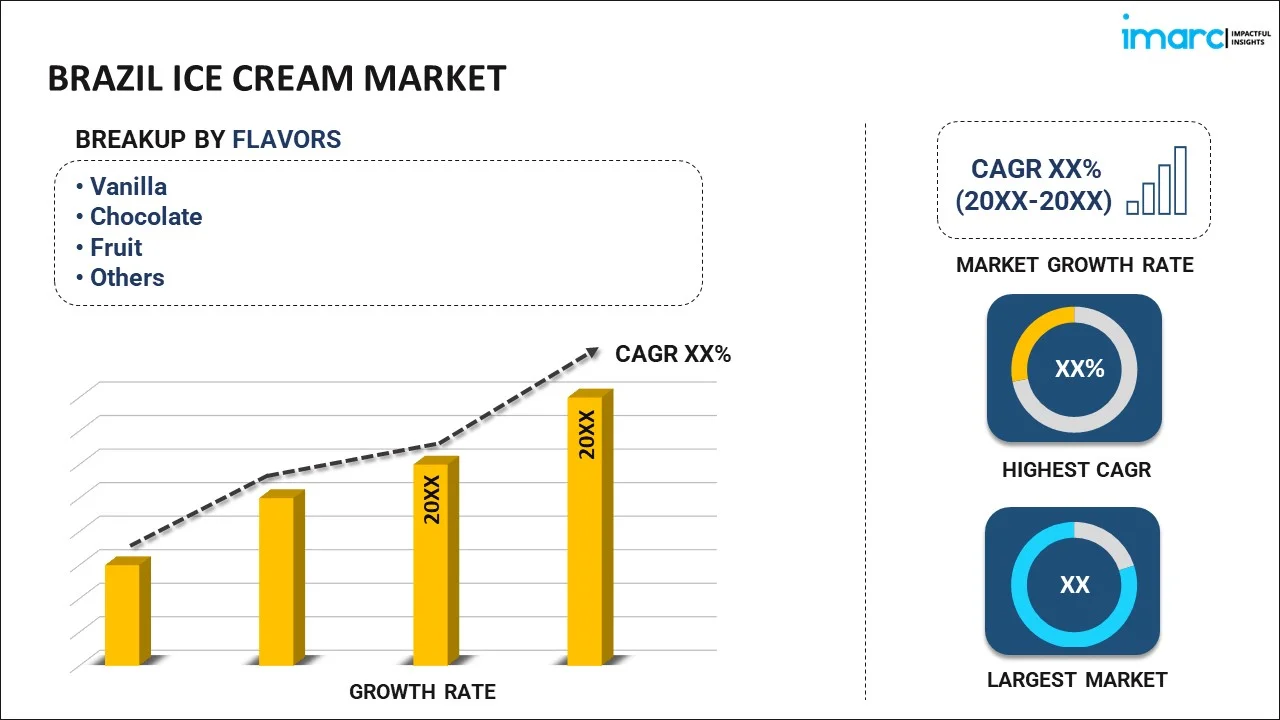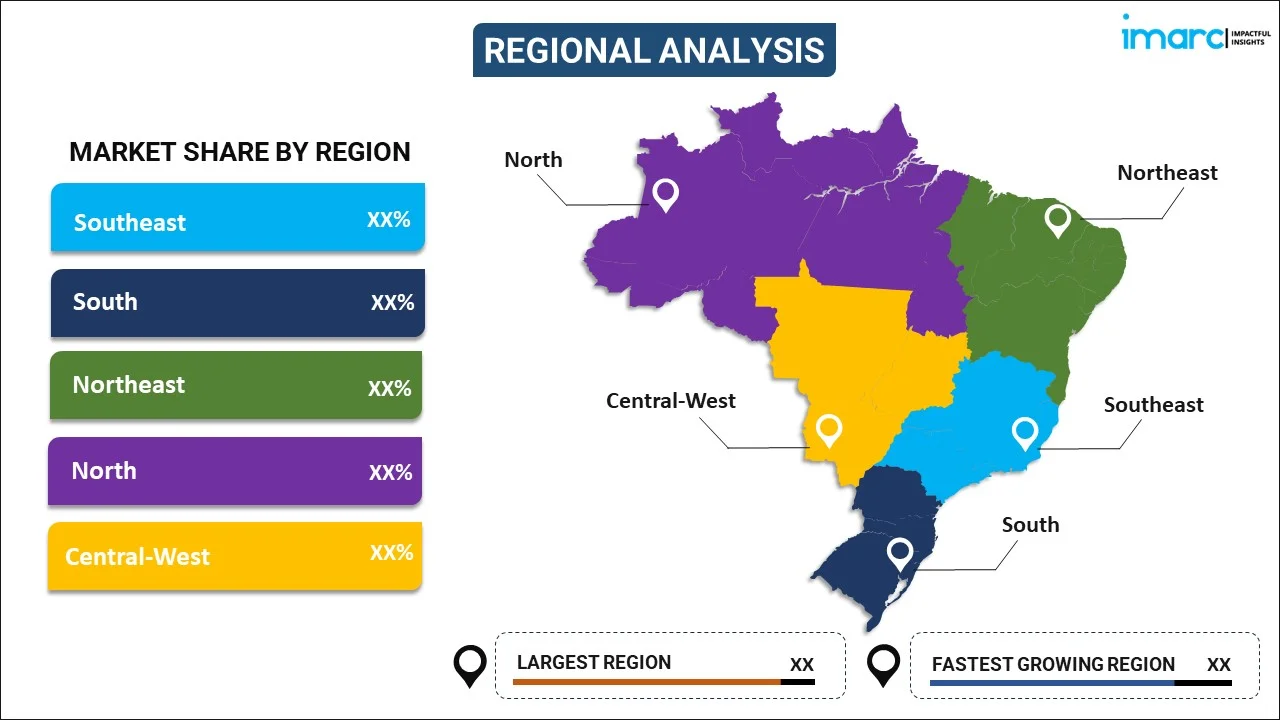
Brazil Ice Cream Market Report by Flavor (Vanilla, Chocolate, Fruit, and Others), Category (Impulse Ice Cream, Take-Home Ice Cream, Artisanal Ice Cream), Product (Cup, Stick, Cone, Brick, Tub, and Others), Distribution Channel (Supermarkets and Hypermarkets, Convenience Stores, Ice Cream Parlors, Online Stores, and Others), and Region 2026-2034
Brazil Ice Cream Market Overview:
Brazil ice cream market size reached USD 1,467.1 Million in 2025. Looking forward, IMARC Group expects the market to reach USD 2,156.0 Million by 2034, exhibiting a growth rate (CAGR) of 4.37% during 2026-2034. Some of the key market drivers include changing consumer preferences, rising disposable income levels, expanding retail channels, seasonal demand for ice cream across the region, rising health and wellness trends, continuous innovation and product diversity, increased export opportunities, a strong cultural affinity for sweets, and the country's warm climate.
|
Report Attribute
|
Key Statistics
|
|---|---|
|
Base Year
|
2025 |
|
Forecast Years
|
2026-2034
|
|
Historical Years
|
2020-2025
|
| Market Size in 2025 | USD 1,467.1 Million |
| Market Forecast in 2034 | USD 2,156.0 Million |
| Market Growth Rate (2026-2034) | 4.37% |
Ice cream is a frozen dessert that has been enjoyed by individuals of all ages for generations. It is a creamy, sweet treat made from a base of milk, cream, sugar, and typically, egg yolks. These ingredients are blended and then churned to incorporate air, resulting in a smooth and airy texture. Ice cream is available in a wide variety of flavors from classic vanilla and rich chocolate to more exotic choices like mint chocolate chip or rocky road, often referenced in a list of ice cream flavors. Ice cream is traditionally served in scoops or on cones, making it a versatile dessert for both sit-down and on-the-go indulgence. It is often enhanced with toppings, such as hot fudge, caramel, nuts, sprinkles, or fresh fruits, to add extra layers of flavor and texture. Ice cream parlors, known for their nostalgic charm, have been serving up this delectable treat for decades, creating a sense of nostalgia and joy for patrons, young and old.
Brazil Ice Cream Market Trends:
Rising Preference for Natural and Plant-Based Options
Consumers in Brazil are increasingly opting for ice cream manufactured with natural ingredients and plant-based alternatives. Growing health and wellness consciousness, along with a move toward lactose-free and vegan lifestyles, has prompted manufacturers to introduce goods that do not use artificial flavors or ingredients. Almond, coconut, and soy-based ice creams are gaining popularity, particularly in metropolitan areas. This tendency is also reinforced by younger populations looking for sustainable and ethical purchasing practices. Brands that stress clean labeling, transparent sourcing, and healthier formulas are gaining traction in Brazil icecream market. The addition of nutrient-dense ingredients such as fruits, seeds, and nuts is making plant-based ice cream a popular option rather than a specialist one.
Emphasis on Authentic Local Flavors and Sustainability
Brazilian ice cream makers are focused on local ingredients and traditional flavors that appeal to regional preferences. Exotic fruits such as açaí, cupuaçu, and cashew are being used to showcase Brazil's diverse biodiversity. Sustainability is particularly important in this trend, with firms using eco-friendly packaging and supporting local farmers through fair procurement procedures. By employing locally grown fruit and lowering reliance on imported ingredients, producers appeal to consumers who value authenticity and environmental sensitivity. Companies are increasingly marketing their ice creams as a cultural and environmental choice, linking indulgence with responsible consumption.
Leveraging Seasonal Demand and Festive Promotions
Brazil’s predominantly warm climate fuels a steady demand for ice cream, but sales peak during summer and festive seasons. Companies are capitalizing on this by launching limited-edition flavors and promotional campaigns tied to holidays and events. Creative marketing strategies, such as collaborations with popular brands or influencers, are driving seasonal engagement. Outdoor advertising, in-store tastings, and festival tie-ins have become common tactics to attract consumers in the Brazil impulse ice cream market. Flavors inspired by tropical fruits or seasonal desserts are often rolled out during high-demand periods, ensuring product freshness and maintaining excitement among customers.
Strong Cultural Connection and Indulgent Consumption
Ice cream in Brazil is more than just a dessert; it is closely tied to moments of relaxation, family gatherings, and leisure. This cultural connection makes it a popular treat across all age groups. Brazilians enjoy experimenting with rich, indulgent varieties that feature combinations like brigadeiro, doce de leite, and tropical fruit swirls. Parlor chains and street vendors alike benefit from this cultural preference, offering both classic and premium options. The market thrives on emotional appeal, with brands positioning their products as part of a joyful, shared experience rather than just a snack. The popularity of ice cream Brazil continues to rise, driven by both traditional favorites and innovative new products. The industry’s focus on authenticity, healthier ingredients, and consumer experiences ensures steady growth and expanding opportunities for both local and international brands entering the Brasil ice cream segment.
Expanding Product Innovation and Variety
Manufacturers are continuously innovating to meet diverse consumer tastes and preferences. Novel formats, such as bite-sized frozen treats, ice lolly, low-sugar formulations, and hybrid desserts combining ice cream with baked goods, are expanding the product range. Premium segments featuring artisanal production and unique textures are becoming increasingly popular. Innovations in packaging, such as single-serve pouches or multi-flavor packs, are designed to enhance convenience. With the rising influence of global dessert trends, Brazilian companies are introducing fusion flavors and gourmet options, setting new benchmarks for creativity and quality in the Brazil frozen fruits market.
Brazil Ice Cream Market Segmentation:
IMARC Group provides an analysis of the key trends in each segment of the market, along with forecasts at the country level for 2026-2034. Our report has categorized the market based on flavor, category, product, and distribution channel.
Flavor Insights:

To get more information on this market, Request Sample
- Vanilla
- Chocolate
- Fruit
- Others
The report has provided a detailed breakup and analysis of the market based on the flavor. This includes vanilla, chocolate, fruit, and others.
Category Insights:
- Impulse Ice Cream
- Take-Home Ice Cream
- Artisanal Ice Cream
A detailed breakup and analysis of the market based on the category have also been provided in the report. This includes impulse ice cream, take-home ice cream, and artisanal ice cream.
Product Insights:
- Cup
- Stick
- Cone
- Brick
- Tub
- Others
The report has provided a detailed breakup and analysis of the market based on the product. This includes cup, stick, cone, brick, tub, and others.
Distribution Channel Insights:
- Supermarkets and Hypermarkets
- Convenience Stores
- Ice Cream Parlors
- Online Stores
- Others
A detailed breakup and analysis of the market based on the distribution channel have also been provided in the report. This includes supermarkets and hypermarkets, convenience stores, ice cream parlors, online stores, and others.
Regional Insights:

- Southeast
- South
- Northeast
- North
- Central-West
The report has also provided a comprehensive analysis of all the major regional markets, which include Southeast, South, Northeast, North, and Central-West.
Competitive Landscape:
The market research report has also provided a comprehensive analysis of the competitive landscape. Competitive analysis such as market structure, key player positioning, top winning strategies, competitive dashboard, and company evaluation quadrant has been covered in the report. Also, detailed profiles of all major companies have been provided.
Brazil Ice Cream Market News:
- In June 2024, Specialitá and Selecta, brands of Duas Rodas, unveiled 18 innovative ice cream ingredients at Fispal Sorvetes 2024 in São Paulo. These launches, inspired by global consumer trends, feature unique flavors and textures aimed at enhancing indulgent experiences. Highlights include the Chocolat Chocolate with Marshmallow Paste and White Chocolate Cream with Blackberry, both pioneering concepts in the Brazilian ice cream market.
Brazil Ice Cream Market Report Coverage:
| Report Features | Details |
|---|---|
| Base Year of the Analysis | 2025 |
| Historical Period | 2020-2025 |
| Forecast Period | 2026-2034 |
| Units | Million USD |
| Scope of the Report | Exploration of Historical Trends and Market Outlook, Industry Catalysts and Challenges, Segment-Wise Historical and Future Market Assessment:
|
| Flavors Covered | Vanilla, Chocolate, Fruit, Others |
| Categories Covered | Impulse Ice Cream, Take-Home Ice Cream, Artisanal Ice Cream |
| Products Covered | Cup, Stick, Cone, Brick, Tub, Others |
| Distribution Channels Covered | Supermarkets and Hypermarkets, Convenience Stores, Ice Cream Parlors, Online Stores, Others |
| Regions Covered | Southeast, South, Northeast, North, Central-West |
| Customization Scope | 10% Free Customization |
| Post-Sale Analyst Support | 10-12 Weeks |
| Delivery Format | PDF and Excel through Email (We can also provide the editable version of the report in PPT/Word format on special request) |
Key Benefits for Stakeholders:
- IMARC’s industry report offers a comprehensive quantitative analysis of various market segments, historical and current market trends, market forecasts, and dynamics of the Brazil ice cream market from 2020-2034.
- The research report provides the latest information on the market drivers, challenges, and opportunities in the Brazil ice cream market.
- Porter's five forces analysis assist stakeholders in assessing the impact of new entrants, competitive rivalry, supplier power, buyer power, and the threat of substitution. It helps stakeholders to analyze the level of competition within the Brazil ice cream industry and its attractiveness.
- Competitive landscape allows stakeholders to understand their competitive environment and provides an insight into the current positions of key players in the market.
Key Questions Answered in This Report
The ice cream market was valued at USD 1,467.1 Million in 2025.
The Brazil ice cream market is projected to exhibit a CAGR of 4.37% during 2026-2034, reaching a value of USD 2,156.0 Million by 2034.
Rising incomes and urban growth expand demand for indulgent treats. Consumers increasingly favor unique regional flavors (açaí, cupuaçu), premium, artisanal, and health-focused options (low-sugar, vegan). Expanded retail (supermarkets, convenience stores, e-commerce), strong seasonality, and innovation in packaging and formats drive growth.
Need more help?
- Speak to our experienced analysts for insights on the current market scenarios.
- Include additional segments and countries to customize the report as per your requirement.
- Gain an unparalleled competitive advantage in your domain by understanding how to utilize the report and positively impacting your operations and revenue.
- For further assistance, please connect with our analysts.
 Request Customization
Request Customization
 Speak to an Analyst
Speak to an Analyst
 Request Brochure
Request Brochure
 Inquire Before Buying
Inquire Before Buying




.webp)




.webp)












